01 Introduction to optical microscopy
Optical microscopes are important means and tools for people to observe small objects and understand the microscopic world. They are also indispensable scientific instruments for people to engage in optical precision measurements, analyze microstructures, observe fine structures, and carry out micro-processing. The simplest optical microscope consists of an imaging system to magnify the sample and an illumination system to illuminate the sample. But most optical microscopes are more complex and contain many high-precision lenses with strictly controlled sizes inside the microscope and its objective and eyepieces.
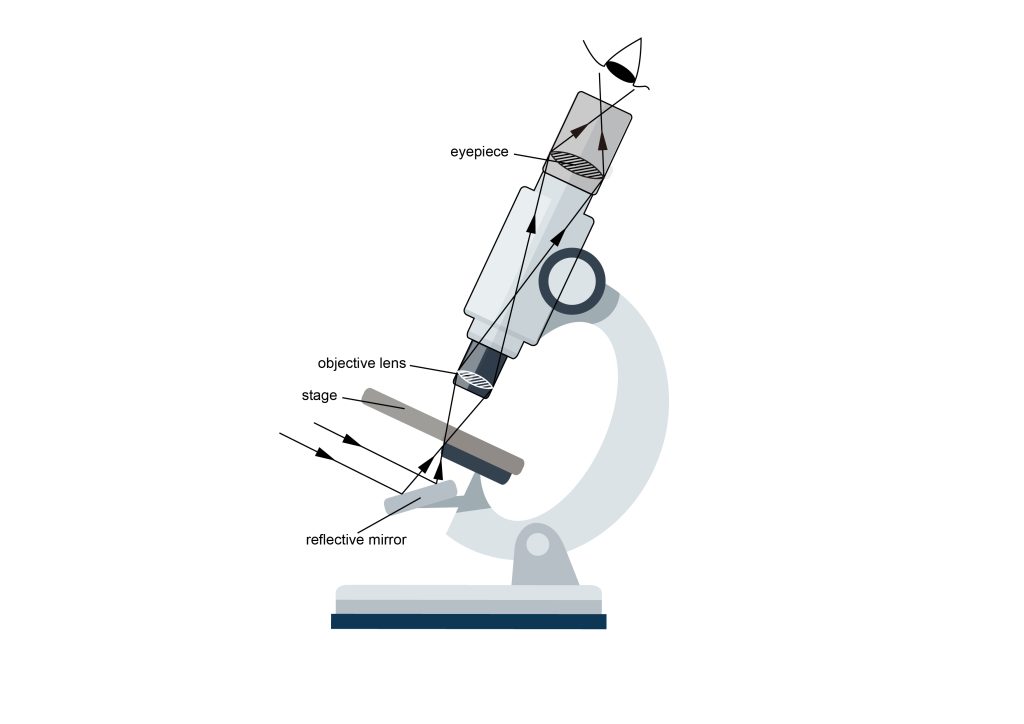
When using a microscope, we always hope to get clear and bright images, which requires the optical technical parameters of the microscope to reach certain standards and requires that the relationship between the parameters must be coordinated according to the actual situation when using it. Only in this way can we give full play to the performance of the microscope and obtain satisfactory microscopic imaging results.
The microscope objective lens is an important part of the microscopic imaging system. It largely determines the magnification and resolution of the microscope. The microscope and microscopic objective lens mainly have the following optical technical parameters:
Magnification
The magnification of the overall microscope system is the product of the magnification of the eyepiece and objective lens. The magnification is usually expressed by a numerical value and “x”, such as 10x, 20x, 50x, etc.;
Numerical aperture NA
Numerical aperture is the most important technical parameter of a microscope objective. It is a dimensionless quantity used to measure the range of the objective lens’s acceptance angle and the angular range of light that the system can collect. The numerical aperture NA is the product of the refractive index n of the medium between the lens and the object and the sine of the semi-aperture angle θ, that is
NA = n × sinθ

resolution
The resolution of a microscope refers to the minimum distance between two object points that can be clearly distinguished by the microscope. The calculation formula is:
σ = λ / NA
where σ is the minimum resolution distance, λ is the wavelength of light, and NA is the numerical aperture of the objective lens.
working distance
The working distance of the objective lens refers to the distance from the bottom surface of the objective lens to the sample surface. When the numerical aperture of the objective lens is constant, the shorter the working distance, the larger the aperture angle.
2 Basic types of objective lenses
The microscope objective is the most critical part of an optical microscope, and it is also the most difficult part to design and assemble. The objective lens is assembled from a series of lenses. The imaging quality of the objective lens directly determines the performance of the microscope system. When choosing a suitable objective lens, in addition to the above-mentioned technical indicators such as magnification and numerical aperture, it is also extremely important to understand the correct aberration correction.
Microscope objectives can be divided into achromatic objectives, apochromatic objectives, plan achromatic objectives, plan apochromatic objectives, etc. according to different aberration correction conditions.
Achromatic objective
It is the most commonly used objective lens in the laboratory. It often has the word “Ach” on the outer shell. It corrects chromatic aberration for blue light (486nm) and red light (656nm), and also corrects spherical aberration for light with a wavelength of 546nm. Achromatic lenses are the best choice for monochromatic light applications.
Apochromatic objective
Apochromatic objectives are marked “Apo” on their housings and require the ability to correct for chromatic aberration in three wavelength regions (red, blue, and yellow). In addition, they can also provide spherical aberration correction for two to three wavelengths and usually have higher numerical apertures and longer working distances. Therefore, the optical structure is more complex, and they usually need to be made of materials such as special glass or fluorite. . Apochromatic objectives are ideal for use in white-light applications.
Plan Objective
Achromatic/apochromatic objectives generally have field curvature problems at high magnifications, that is, the image field is no longer flat but curved. Planar objectives correct the field curvature during objective lens design to improve edge vision. Field aberration turns a curved field into a flat surface. Plan objective lenses are marked with the word “Plan” on their housings.
Infinite conjugate & finite conjugate
Infinite conjugation and finite conjugation refer to the two conjugate surfaces of the object surface and image surface of the microscope objective.
As shown in Figure 3a, with a finite distance conjugate microscope objective, the light scattered from the sample is converged to a point by the objective lens, and then imaged through the eyepiece;
As for the infinity conjugate microscope objective, as shown in Figure 3b, the light leaving the aperture of the objective lens will be collimated. In imaging applications, a tube lens is needed to focus the collimated light from the objective lens on the sensor. The housing of the infinity conjugate microscope objective lens is marked with the word “∞”.
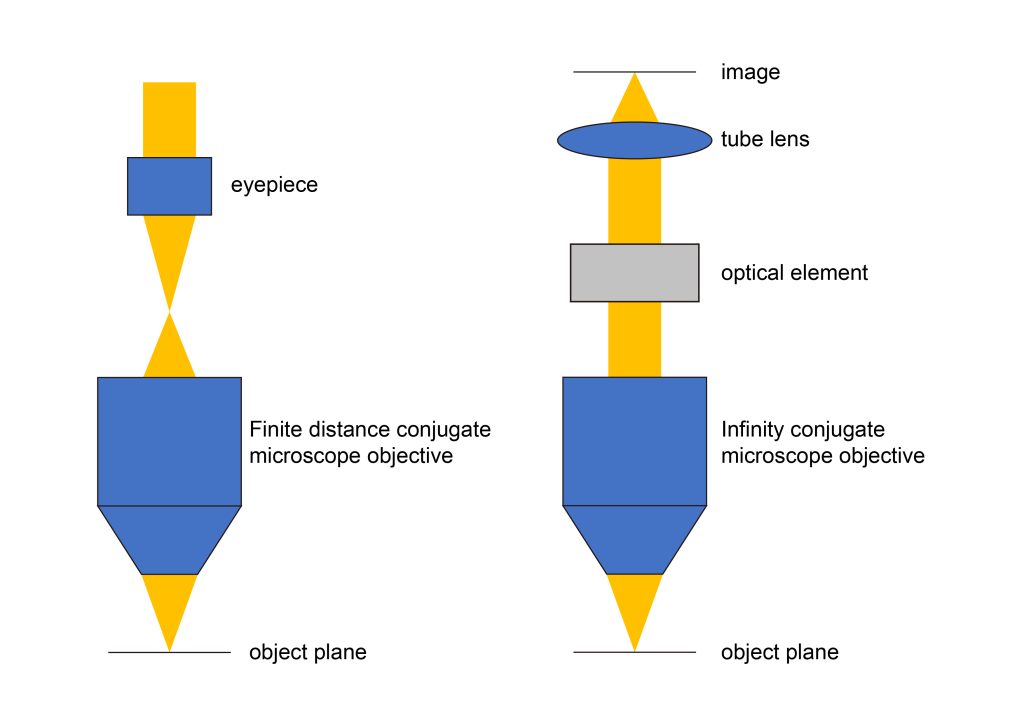
Compared with the finite conjugate objective lens, the advantage of the infinity conjugate objective lens is that polarizers, filters, etc. can be inserted between the infinity conjugate objective lens and the tube lens without changing the beam propagation direction.
The specifications of most objective lenses are printed on the objective lens barrel, and users can easily identify them when using them. Take the infinity-corrected long working distance microscope objective lens launched by United Optical Technology as an example to understand what the logo means.
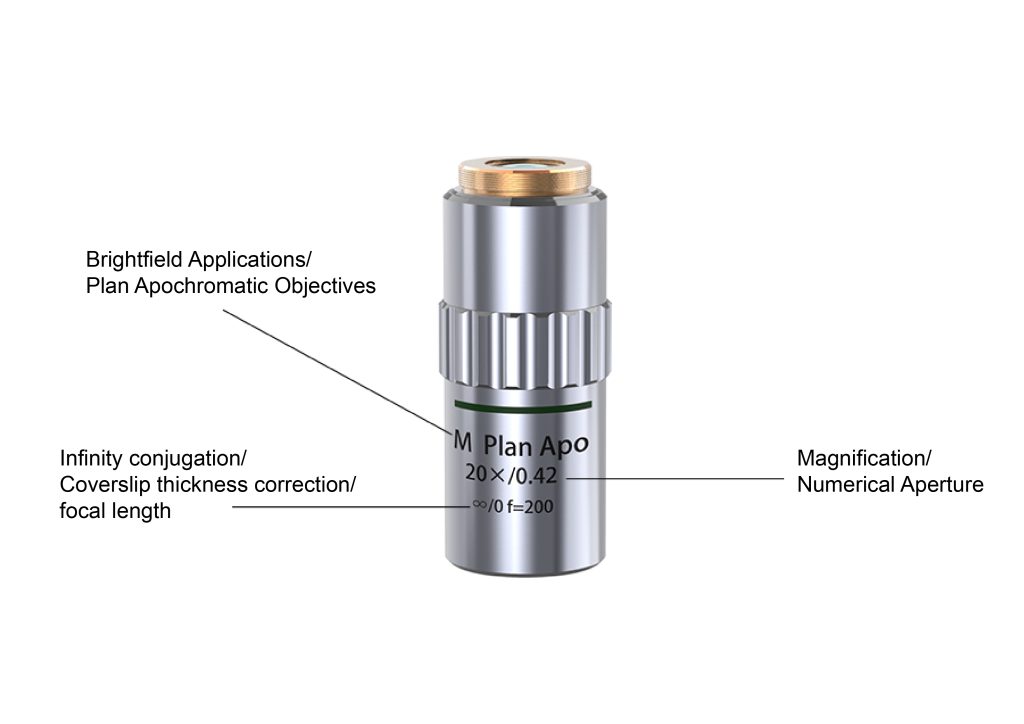
3 Applications of infinity corrected long working distance microscope objectives
Infinity-corrected long working distance plan apochromatic objectives represent the highest level of microscope production today and are increasingly used in semiconductors, electronics, metallurgy and other industries. With their excellent imaging quality, ultra-long working distance, and large Numerical aperture and other characteristics are widely used in laser micro-nano processing, laser micro-beam systems, bright-field industrial inspection and other occasions.
Applications in laser microbeam operating systems
The laser microbeam operating system can realize non-contact cell manipulation in genetic engineering. The “optical tweezers” and “light knives” in the system rely on high-quality microscope objectives.
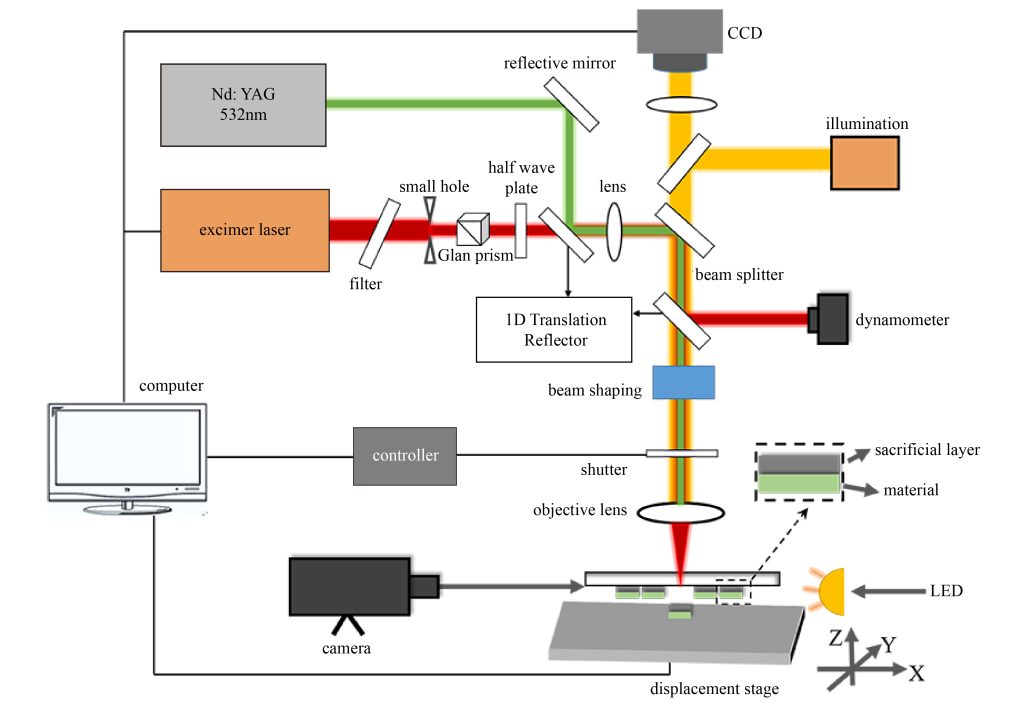
Application of femtosecond laser micro-nano processing
Femtosecond laser micro-nano processing often processes materials in a very small space, a very short time and under extreme physical conditions. The use of infinite conjugate long working distance, apochromatic designed microscope objectives can direct the laser beam Focusing close to the diffraction limit results in a high energy density, which enables the ability of a small area in the center of the pulse to exceed the ablation threshold and achieve feature structures smaller than the focus.
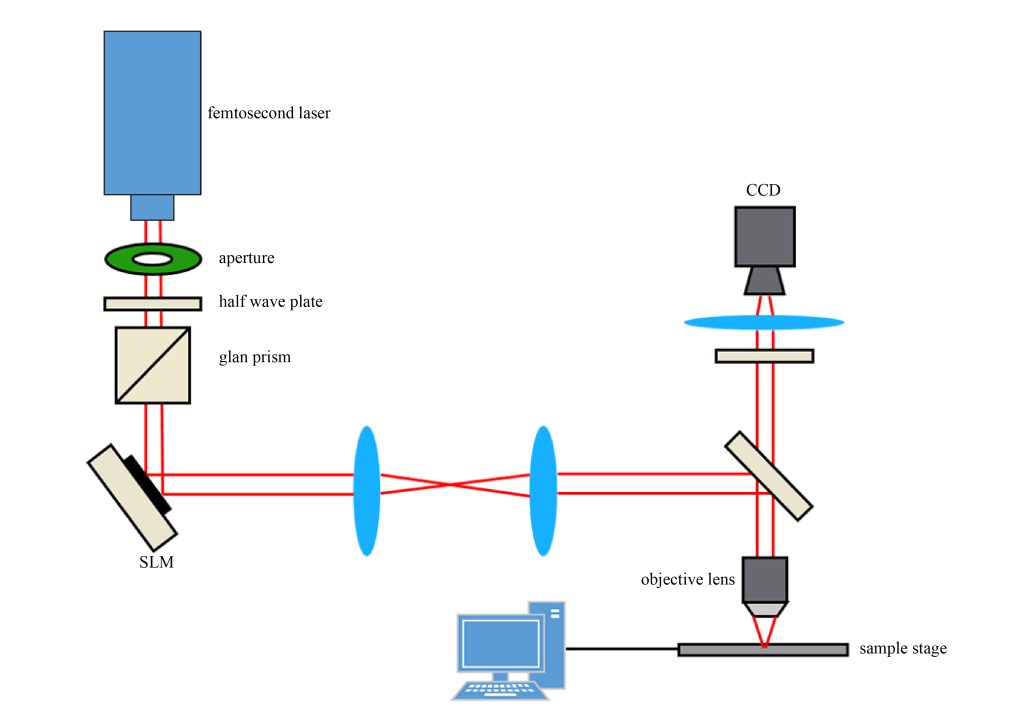
Applications in industrial testing
Infinite conjugate long working distance microscope objectives are also widely used in industrial microscopic topography detection. Figure 7 shows the application in a profilometer based on the confocal display principle, which can realize the detection of 3D topography and the measurement of key dimensions.
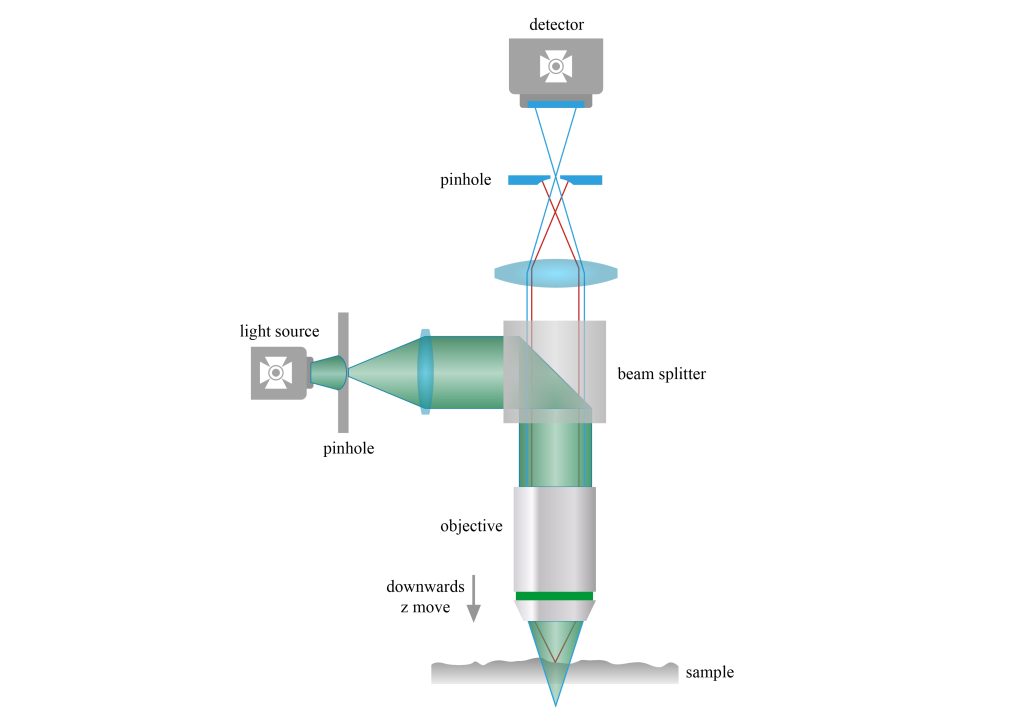
4 Infinity corrected long working distance microscope objective lens product introduction
The long working distance microscope objectives of 2X, 5X, 10X, 20X, 50X, and 100X have a spectral wavelength range of 400-700nm. The objective adopts a plan apochromatic design and can correct red, blue, and yellow light. , with the characteristics of long working distance and large numerical aperture, these objectives are widely used in bright field industrial inspection, education and scientific research, and other fields.
| The main parameters | ||||
| Product No. | Magnification | Numerical Aperture | Focal Length/mm | Resolution Capacity/um |
| 690000 | 2x | 0.06 | 100 | 5 |
| 690002 | 10x | 0.28 | 20 | 1 |
| 690003 | 20x | 0.42 | 10 | 0.7 |
| 690004 | 50x | 0.55 | 4 | 0.5 |
| 690005 | 100x | 0.7 | 2 | 0.4 |